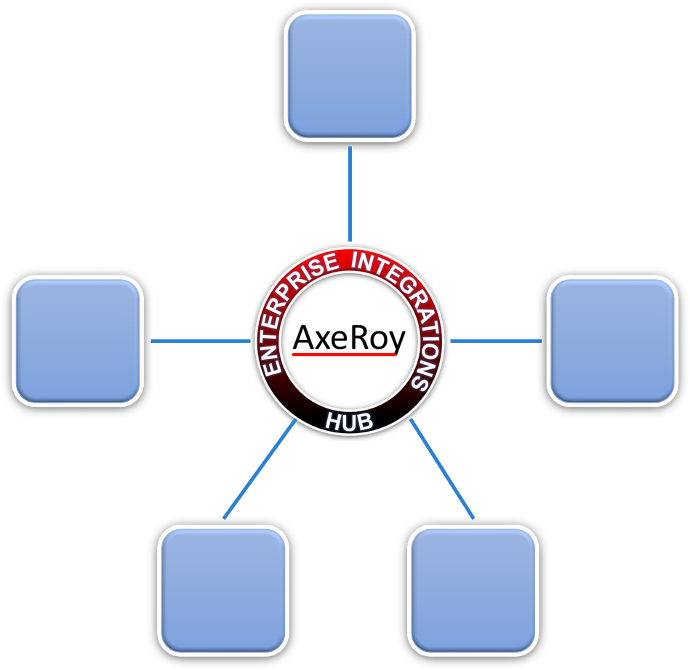Any-Point Integrations
Building Bridges Between Systems
Architecture Options for Systems Integration
In the realm of enterprise systems integration, selecting the right architecture is crucial for ensuring seamless communication and data flow between disparate systems. The choice of architecture often depends on the specific needs and complexity of the integration project. AxeRoy provides three architecture options: point-to-point, many-to-1, and many-to-many, each offering distinct advantages and use cases.
Point-to-Point Integration
Building Bridges Between Two Systems
Point-to-point integration, also known as 1-to-1 integration, is a straightforward approach that establishes a direct connection between two systems. This architecture is ideal for scenarios where two systems need to share data exclusively with each other. Here are some key characteristics and considerations:

Advantages
Simplicity
Point-to-point integration is relatively simple to set up and manage, making it a cost-effective choice for small-scale integrations.
Low Latency
With fewer intermediaries, data transfer between two systems tends to be fast and efficient.
Customization
It allows for fine-tuning and customization of the integration to meet specific requirements.
Considerations
Scalability
This approach can become unwieldy when integrating multiple systems, as each new connection requires individual maintenance and updates.
Maintenance Overhead
As the number of integrations increases, so does the effort required to maintain them.
Complexity with Many Systems
It becomes impractical when dealing with many systems that need to communicate with each other.
Many-to-1 Integration
Centralizing Data Flow
Many-to-1 integration, also known as hub-and-spoke integration, consolidates multiple connections into a central hub or middleware, which then communicates with various systems. This architecture is suitable for scenarios where multiple systems need to interact with a single, centralized system:

Advantages
Centralization
It simplifies management by routing data through a central hub, reducing the number of connections to be maintained.
Scalability
As new systems need to be integrated, they can be connected to the central hub without creating a complex web of point-to-point connections.
Consistency
Data transformations and mappings can be standardized, ensuring consistency in data handling.
Considerations
Hub as a Single Point of Failure
The central hub can become a single point of failure, so redundancy and failover mechanisms are essential.
Latency
Depending on the architecture and the hub's performance, there may be slightly higher latency compared to point-to-point integrations.
Bottleneck Risk
In highly transactional environments, the central hub may become a bottleneck if not designed to handle high data volumes efficiently. Adequate scalability measures are required to mitigate this risk.
Many-to-Many Integration
Orchestrating Complex Ecosystems
Many-to-many integration is designed for complex ecosystems where multiple systems need to communicate with one another in a flexible and dynamic manner. This architecture often relies on an integration platform that supports a variety of connectors and protocols:

Advantages
Flexibility
It accommodates intricate integration scenarios where multiple systems interact with each other.
Adaptability
As new systems join the ecosystem, they can be integrated more easily without significant disruption.
Efficiency
Complex data transformations, orchestration, and business process management can be handled within the integration platform.
Considerations
Complexity
Implementing and maintaining many-to-many integrations can be complex and may require skilled resources.
Scalability
While flexible, it can become challenging to manage as the number of systems and connections grows.
Data Consistency
Ensuring data consistency and integrity across multiple interconnected systems can be challenging. Proper data governance and synchronization mechanisms are crucial to maintaining data quality.
In summary...
selecting the right architecture is pivotal for seamless data flow and efficient communication between diverse systems. At AxeRoy, we understand the significance of choosing the optimal integration approach to drive your business forward. We offer a range of integration services tailored to your unique needs, empowering your organization to thrive in today's interconnected digital landscape.
1. Point-to-Point Integration: Building Bridges with Precision
Our experts at AxeRoy excel in crafting point-to-point integrations, ensuring direct and precise connections between two systems. We help you streamline data exchanges between specific applications, providing simplicity, low latency, and customization. With AxeRoy, your 1-to-1 integrations are finely tuned to meet your exact requirements, delivering efficiency and cost-effectiveness.
2. Many-to-1 Integration: Centralizing Data Flow for Efficiency
AxeRoy's approach to many-to-1 integration (hub-and-spoke) goes beyond just centralizing data flow. We create a robust hub that acts as the nerve center of your integration ecosystem. Our solutions simplify management, enhance scalability, and ensure data consistency. Partner with us to eliminate the complexities associated with maintaining numerous point-to-point connections while enjoying the benefits of centralized control.
3. Many-to-Many Integration: Orchestrating Complex Ecosystems with Ease
Navigating complex ecosystems is our forte at AxeRoy, and our many-to-many integration expertise shines in orchestrating intricate interactions between multiple systems. We provide the flexibility needed to adapt to evolving integration requirements. Count on AxeRoy to efficiently manage the complexity, scalability, and data consistency challenges associated with connecting a multitude of systems.
At AxeRoy, we don't just offer integration solutions; we empower your organization with architecture options that align with your goals. Our experts collaborate with you to choose the right integration strategy, implement it effectively, and ensure that your systems seamlessly communicate. With AxeRoy as your partner, you can harness the power of integration architectures to drive your business success, streamline operations, and stay ahead in a rapidly evolving digital landscape.